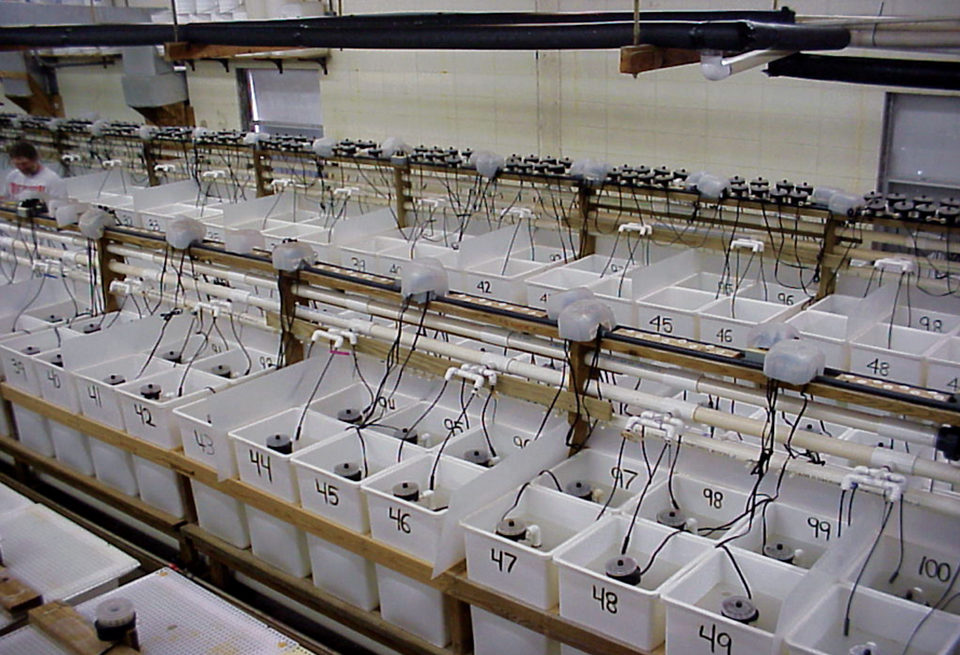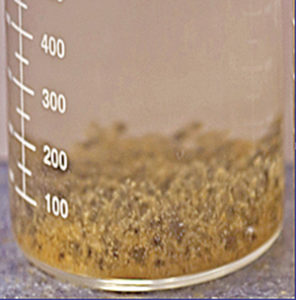Single-celled proteins produced in biological reactors can clean up effluent waters

Fishmeal is a popular ingredient for aquaculture feeds because it provides high-quality nutrition in the form of proteins, highly unsaturated fatty acids and minerals, and is extremely palatable. However, fishmeal is mainly derived from wild stocks, which are overexploited in certain regions of the world. Fishmeal is also affected by economics: U.S. prices for fishmeal nearly quadrupled over the last decade.
For these reasons, researchers and the aquaculture industry are increasing their use of alternative feed ingredients. One success story has been the use of soy protein in place of fishmeal in some aquaculture feeds. Other alternative ingredients are being investigated as well, including single-celled protein meals – also known as microbial flocs or simply bioflocs.
In recent years, several researchers and industry groups have begun exploring novel ways to produce these single-celled ingredients, not only for use as a potential feed ingredient, but also to accomplish other goals. The authors’ research group at Virginia Tech, for example, has demonstrated that single-celled proteins produced in biological reactors can clean up effluent waters from aquaculture facilities. This biological process converts dissolved nutrients (nitrogen and phosphorus) into proteins contained within bioflocs.
Feeding trials
The authors’ studies evaluated bioflocs produced in biological reactors as a replacement for both soy and fishmeal proteins in shrimp diets. Several feeding trials were conducted in partnership with the Texas A&M University system to compare high-quality shrimp diets with and without bioflocs.
Shrimp grew 10 to 50 percent faster on diets that contained bioflocs compared to those without them. So an important question needs to be answered. What was contributing to the increased growth rates observed in shrimp that received the biofloc-containing diets?
What we know

Although researchers have not fully quantified what is in bioflocs, they know that bioflocs produced in biological reactors are a consortium of microorganisms, micro- and macroinvertebrates, filamentous organisms, exocellular polymers and uneaten feed.
In the biofloc feeding trials, feeds were formulated to be equivalent for crude protein, carbohydrate, crude fat, crude fiber and energy. Using standard laboratory methods and semi-purified diets, the authors validated that all diets with and without bioflocs contained identical levels of many nutrients. Thus, none of the nutrients contributed to the increased growth rates observed in the biofloc-fed shrimp.
This naturally led to other questions – could there be an individual fatty acid parameter in bioflocs that contributed to enhanced shrimp growth? Or a sterol such as cholesterol? How about an individual amino acid, the building blocks of proteins?
The answers to the fatty acid and sterol questions were both “no.” The fatty acid and cholesterol levels in the bioflocs were negligible. In some cases, none was detected. Furthermore, highly unsaturated fatty acid (HUFA), polyunsaturated fatty acid (PUFA) and sterol levels in all diets were constant. Therefore, it was impossible that a sterol, HUFA or PUFA contributed to the enhanced shrimp growth.
In regards to amino acids, the answer was also no. When individual amino acid profiles were measured in the formulated feeds with and without bioflocs, no difference was found among the experimental feeds.
How about a vitamin or mineral? Could one of these have contributed to increased shrimp growth? No. All essential vitamins and minerals – such as calcium, phosphorus, potassium, sodium, manganese, zinc and copper – in the feeds with and without bioflocs were formulated to be either constant or in excess, so these would not be a factor in the feed trials.
Like all animals, shrimp have an optimum daily requirement for each specific vitamin or mineral. When this optimum concentration is exceeded, the presence of additional amounts no longer contributes to further enhancement of growth. Since all feeds were formulated to contain vitamins and minerals constant or in excess of what was needed, the presence of any particular vitamin or mineral within bioflocs did not contribute to the accelerated growth.
What we don’t know
At the current time, we don’t know what in bioflocs is contributing to accelerated growth. Is it an unknown growth factor? An unknown chemoattractant? An unknown stress-resistance factor? Perhaps a nutritional component that is not well understood or measured for shrimp nutrition – a bioamine, dipeptide, oligopeptide, oligosaccharide, nucleotide, prebiotic, chemoattractant or growth promoter?
Perspectives
Even though we have not yet identified what component of bioflocs accelerates shrimp growth, knowledge of what does not contribute can help us better understand shrimp nutrition and lead to innovative findings in the future.
From an industry standpoint, this is not as important as the demonstrated benefits that biofloc can offer. Bioflocs are advantageous because they are produced in a manner that is not only sustainable, but may also offer valuable water treatment options, resulting in an alternative ingredient to fishmeal in shrimp diets.
(Editor’s Note: This article was originally published in the March/April 2011 print edition of the Global Aquaculture Advocate.)
Authors
-

David D. Kuhn, Ph.D.
Food Science and Technology Department
Virginia Tech/Virginia Sea Grant (0418)
Blacksburg, Virginia, 24061 USA -
Addison L. Lawrence, Ph.D.
Texas A&M University
Port Aransas, Texas, USA -
Greg D. Boardman, Ph.D.
Virginia Tech/Virginia Sea Grant (0418)
Blacksburg, Virginia, 24061 USA -

George J. Flick, Ph.D.
Virginia Tech/Virginia Sea Grant (0418)
Blacksburg, Virginia, 24061 USA
Tagged With
Related Posts

Health & Welfare
A holistic management approach to EMS
Early Mortality Syndrome has devastated farmed shrimp in Asia and Latin America. With better understanding of the pathogen and the development and improvement of novel strategies, shrimp farmers are now able to better manage the disease.

Health & Welfare
Aquamimicry: A revolutionary concept for shrimp farming
Aquamimicry simulates natural, estuarine production conditions by creating zooplankton blooms as supplemental nutrition to the cultured shrimp, and beneficial bacteria to maintain water quality. Better-quality shrimp can be produced at lower cost and in a more sustainable manner.

Aquafeeds
Biofloc consumption by Pacific white shrimp postlarvae
The stable isotopes technique with δ13C and δ15N can be used to determine the relevance of different food sources to shrimp feeding during the pre-nursery phase of Litopenaeus vannamei culture. During this trial, different types of commercial feed, microalgae, Artemia sp. nauplii and bioflocs were used as food sources.

Aquafeeds
Biofloc systems viable for tilapia production
Well-designed and managed biofloc technology systems are a viable alternative for production of various species like tilapia, to increase feed efficiency by lowering aquafeed protein requirements and to help reduce or eliminate effluent discharges.


